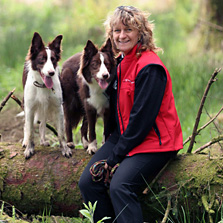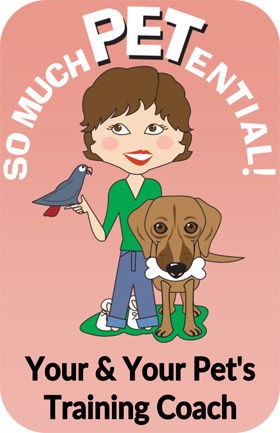dog training
Want A Pet Who Loves To Learn? Make Training Fun
NOTE: I have a new pet behavior blog located at http://www.SoMuchPETential.com/blog. Thanks!
I was at a friend’s house the other day who was telling me she wished her dog would come when she called. “He just wouldn’t listen,” she’d say.
I didn’t have to observe long to get a sense of at least one of the underlying explanations. I’ll paint a picture to see if you get a sense too. Her dog was outside having a perfectly good time where there is so much sensory stimulation outside – noises, smells, sights. She opened the door and called him in. He did come (this time) and the reaction he received upon coming was simply a nondescript voice saying ‘good boy Willy’.
“Hmmm,” I could visualize Willy saying to himself. “Big deal. Why should I give up my perfectly good time to come for THIS?”
I see that a lot actually. Pet owners being frustrated because their dogs won’t follow their ‘commands’ and blaming the dog. Part of the whole problem is our thinking about what we want our pet to do in terms of a ‘command’. That word alone connotes dominance and force, not a very motivating and encouraging way to learn.
I’m not going to get much into behavior analysis in this post but I do want to offer a suggestion. What if, instead of thinking about telling your dog to do a command, you think about how you can put the fun back in learning? You put the responsibility on yourself to make the behavior you want to teach, a behavior that is just super cool to do because what happens right after the behavior is so high value.
I tell people all the time how much our Sam loves to learn. The other day, in just a couple of five minute sessions, I taught him to scratch an itch on his nose. (Unfortunately Sam got adopted into a family with a very silly trainer.)
The truth is, Sam loves to learn because I’ve made it so much fun. (Well, I’m also very consistent in reinforcing the behavior I want to see but that is a separate topic for a separate column.) That time we share is really quality time together. When I’m initially teaching a behavior (usually through shaping), he loves the challenge of trying to figure out what he needs to do to get me to shout in my very animated voice, ‘GOOD BOY’, which is followed by a favorite treat. And when we are going through his repertoire of behaviors, he does each one so enthusiastically because we make it one great party.
To everyone who has a dumb or obstinate dog, I challenge you. Instead of holding your dog up to expectations, hold yourself up to creating an environment that fosters a love of learning.
Dr. Ian Dunbar Talks About Positive Dog Training on TED
NOTE: I have a new pet behavior blog located at http://www.SoMuchPETential.com/blog. Thanks!
Veterinarian, dog trainer, and animal behaviorist Dr. Ian Dunbar works to encourage better relationships with dogs — not to mention their friends and children, too. His Sirius Dog Training Company focuses on training puppies to be playful, yet well-behaved. His second organization, Animalin, promotes games for dogs and puppies at an international level.
He has also written numerous books, including How to Teach a New Dog Old Tricks and The Good Little Dog Book. He has also hosted several award-winning videotapes on puppy and dog training.
Below is his TED Talk. Great information!
Susan Garrett’s Dog Training Tips From APDT Conference
NOTE: I have a new pet behavior blog located at http://www.SoMuchPETential.com/blog. Thanks!
Last weekend, hun dreds of dog trainers (actually probably upwards of close to 1000) from across the country converged on Covington, Kentucky. It was the very first time that the Association of Professional Dog Trainers (APDT) has held its large annual conference here and I was fortunate to be among the attendees. I attended three of the five days. Not only did I learn a ton from some of the top and most respected professionals in the business, it was also an opportunity to meet highly skilled trainers who believe as I do in the power of positive reinforcement.
dreds of dog trainers (actually probably upwards of close to 1000) from across the country converged on Covington, Kentucky. It was the very first time that the Association of Professional Dog Trainers (APDT) has held its large annual conference here and I was fortunate to be among the attendees. I attended three of the five days. Not only did I learn a ton from some of the top and most respected professionals in the business, it was also an opportunity to meet highly skilled trainers who believe as I do in the power of positive reinforcement.
I’ll be writing about and referring to the conference in numerous posts.
Training Tips from Susan Garrett
What an amazing opportunity it was that the very first lecture I attended was a three hour presentation by Canada’s Susan Garrett, owner of Say Yes Dog Training, from whom I had taken an online course, the Five Minute Recall. Susan is one of the most successful dog agility competitors of the last decade. She is also a member of one of the fastest flyball teams in the world.
Susan gave us so much information. She also shared these tips for success:
Be the Keeper of the Joy.
“Training is just building joy for what I do want, while controlling access to reinforcement for what I don’t want. Be sure you build yourself into all reinforcement.”
Take regular reinforcement inventory. Ask yourself – where is the value?
Know where you are and where you would like to go. Develop an ‘it is what it is’ attitude.
“When I look at my dogs, all I see is greatness. It’s up to me to show the world.”
Let average or better be your guide.
Plan for failures and only reward responses that take you closer to your goals.
Use arousal to develop skills that are resistant to distraction.
Don’t train in a sterile environment. Deepen your dogs understanding of your cues and his responses by cranking up the excitement level. A brief game of tug or chase will break things up and keep him excited. Make your dog say to you, ‘don’t wanna don’t have to’ and work through it.
And remember…
The more time you put into your puppy in its first 12 months, the more joy you will get out of him for the next 16 years of life.
About APTDT
The Association of Pet Dog Trainers (APDT) is a professional organization of individual trainers who are committed to becoming better trainers through education. The APDT is dedicated to building better trainers through education, promoting dog-friendly methods and encouraging their use. Our membership is composed of trainers from across the spectrum of training philosophies who have an interest in furthering their knowledge of positive training.
Pet Dominance: Myth or Fact?
NOTE: I have a new pet behavior blog located at http://www.SoMuchPETential.com/blog. Thanks!
(This one of my past Hyde Park Living columns.)
Many unwanted behaviors like pulling on a leash, growling, barking, or biting are blamed on dominance. “They’ve got that alpha dog thing going on.”
Well, as Susan Friedman, Ph.D., has taught me, dominance is nothing more than a label for a behavior – a description of  what we as humans ‘think’ explains the problem behaviors we have with our pet. The problem is, a label is simply nothing more than an intangible explanation that doesn’t even specify what the observable behavior is or the condition in which it is behaved. Behavior plus conditions is the smallest meaningful unit of behavior analysis. And, unfortunately a label ultimately leads to a self fulfilling prophecy because how we react and how our animal responds to our actions leads to stronger behaviors. Giving behaviors labels stops us from our search for finding a positive solution for modifying that behavior.
what we as humans ‘think’ explains the problem behaviors we have with our pet. The problem is, a label is simply nothing more than an intangible explanation that doesn’t even specify what the observable behavior is or the condition in which it is behaved. Behavior plus conditions is the smallest meaningful unit of behavior analysis. And, unfortunately a label ultimately leads to a self fulfilling prophecy because how we react and how our animal responds to our actions leads to stronger behaviors. Giving behaviors labels stops us from our search for finding a positive solution for modifying that behavior.
How does the self-fulfilling prophecy come to play in talking about the alpha dog? Well, a couple months back I wrote about the dangers of using a technique called flooding (a form of training in which the animal is exposed to an aversive stimulus with no possibility of escape until the stimulus no longer arouses anxiety – labeled as dominance – in the animal). One claim is that you should force your puppy onto its back, not letting him up until he stops resisting. Some may say that is teaching your dog to be submissive but behaviorists will say that is creating learned helplessness, and if you are looking to build a strong, positive relationship with your dog – that is not the way to do it.
I digressed. So, this ‘alpha dog’ concept – it stems from studies of wolf packs in the 1940s. Dr. Ian Dunbar, founder of the Association of Pet Dog Trainers: 1) Those studies were short term and focused only on the most obvious facet of wolf life – mainly hunting. 2) Researchers observed what are now known to be ritualistic displays and misinterpreted them. 3) Researchers made some wild extrapolations from their data.
The fact is, dogs are to wolves what chimpanzees are to humans. They became a separate species well over 100,000 years ago. In that time there has been domestication, co-evolution with humans and selective breeding.
Behaviorists like my teacher and mentor Susan Friedman, Ph.D., and trainers who I’ve studied from such as Steve Martin, Barbara Heidenrich, and Susan Garrett instead focus on setting animals up for success. They look at the specific behavior to be modified or taught in terms of the purpose that behavior serves the animal in its environment. They reinforce behaviors they want to see. And they empower animals by putting the power of choice in the animal’s control and simply modifying the consequences (and/or the antecedents) to make the desired behavior the best choice.
So, let me recap. If you really want your dog to do what you want him to do, stop labeling him as dominant and stop using the excuse that he is a pack leader alpha dog. (Or that you have to be the alpha dog.) Instead, see yourself as a teacher and your dog as your student. Every unwanted behavior is an opportunity to teach a new skill.
My Thoughts On Positive Reinforcement Vs Dominance In Training
NOTE: I have a new pet behavior blog located at http://www.SoMuchPETential.com/blog. Thanks!
(This is a past Hyde Park Living column.)
People I meet around town are always surprised when I have negative reaction to Caesar Millan. And, it is that surprise that is the very reason why I want to share another view…one on the power of positive reinforcement and the importance of understanding behavior.
To those who believe it is important to be the alpha dog or pack leader, to assert your dominance, I’ve got to ask. How  does it help to foster a love of learning in your pet?
does it help to foster a love of learning in your pet?
One of Ceasar’s strategies for dealing with unwanted behaviors such as fear or aggression (or fear induced aggression) is a technique called flooding. Let me explain. Flooding is a form of training in which the animal is exposed to an aversive stimulus with no possibility of escape until the stimulus no longer arouses anxiety or fear. But can you imagine the level of anxiety and discomfort it causes the animal in the process? It is either sink or swim basically.
Here is an example of how I have seen Caesar work with a dog that exhibits strong aggressive tendencies to children on the street (this would be described as showing his teeth, snarling, having a tense body, and even biting if given the opportunity). He brought the dog on a leash to the sidewalk and had children ride their scooter past the dog, holding it down while the dog struggled and struggled until finally the dog stopped tensing up.
Television viewers saw it as the dog who learned to be submissive and calm. I cringed. Animal behaviorists have another word for it…learned helplessness. Learned helplessness occurs when an animal is repeatedly subjected to an aversive stimulus that it cannot escape. Eventually, the animal will stop trying to avoid the stimulus and behave as if it is utterly helpless to change the situation. Even when opportunities to escape are presented, this learned helplessness will prevent any action.
An example of learned helplessness that you may be able to relate to is Jaycee Dugard, who stopped trying to escape her kidnapper, abuser and father to her children after she realized it would do her no good to try. Yes, she learned how to be calm but what an extreme price to pay for it.
Think about yourself. If you were terrified of tarantulas and someone thought the best way to get you over your fear was to tie you down and cover you with the spiders until you finally quit squirming…how would that make you feel about overcoming fears? How would you feel about the person who wanted to do that to you? Do you think you would be more apt or less apt to be able to cope with other fear inducing situations in the future because of it? Speaking for myself, I can tell you I would probably never forget the feeling of total fear that that person subjected me to.
Systematic desensitization is a much more humane, more positive approach to not just overcoming fear, but also to teaching the animal to re-associate the fear-eliciting stimulus into a feel-good eliciting stimulus. (This process is called counter conditioning.) With systematic desensitization, you gradually expose the animal to what is scary to it and the criteria for advancing to the next step is your watching his calm behavior and only moving forward at a pace that does not elicit even the mildest of fear responses. The beauty of this is that the animal is always in total control. And I don’t know about you but I like knowing I have the power to control my situation.














